Brooklyn may be awash in Dumpster pools, make-your-own-bitters classes, and Mason jars of house-cured pickles, but nowhere is the borough’s DIY spirit more pronounced than at Roberta’s in Bushwick. When it was opened by a trio of friends in January 2008, it was a down-home, weld-it-yourself antidote to such high-bubble culinary temples as Gilt and Per Se, serving scruffy locals and slumming gourmands exuberantly topped wood-fired pizza and tuned-up entrées like lamb breast with spigarello, mint gelée, and smoked ricotta. The soul of the place isn’t found in the kitchen, however, but in the restaurant’s backyard, where, hemmed in by cinderblock, razor wire, and corrugated steel, a garden—and many other things—grows. Herbs, flowers, and tomatoes sprout from repurposed tires and plastic hops bins. Craned-in shipping containers house a radio station and bakery, plus an office, all crowned by small vegetable patches. The vibe is of a future-primitive, self-sufficient compound whose inhabitants grow their own food and urinate on the compost pile (true story).
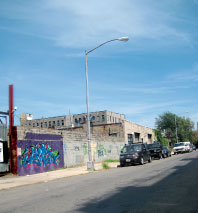 |
(Photo: Leonor Mamanna) |
2004: Chris Parachini, a musician/bartender/conceptual artist, moves from Williamsburg (“to escape the mommy-daddy-baby set”) to Bushwick, the center of a nascent DIY scene. “The neighborhood was lawless,” he says. “We were launching giant fireworks out of my window literally for hours, and the cops never came.”
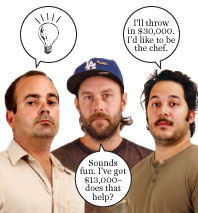 |
(Photo: Boru O'Brien O'Connell/New York Magazine) |
Thanksgiving 2006: Parachini gets the idea for Roberta’s one night after eating at Frank Pepe, the famous New Haven pizzeria. Hoy, a fellow musician, signs up to contribute $13,000. By the following March, they have a lease and the keys, and are doing demolition work.
Fall 2007: Bartending nights and building the restaurant all day, they soon run out of money. Up steps a third partner, ex–Good World cook Carlo Mirarchi, who has $30,000 to spare and wants to be the chef.
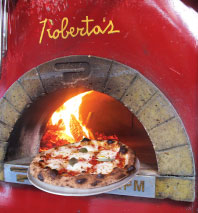 |
(Photo: Roxanne Behr/New York Magazine) |
January 2008: After nearly two years, Roberta’s finally opens—with no heat, no gas, and no hot water. The owners won’t get a liquor license for eleven more months. They spread five space heaters throughout the restaurant, and Mirarchi cooks on butane burners for the first fourteen months. He braises stews and roasts porchetta at home, then reheats them in a toaster.
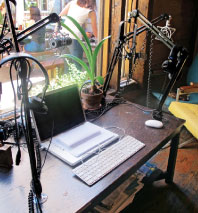 |
(Photo: Roxanne Behr/New York Magazine) |
June 2008: Patrick Martins, a Slow Food activist and the purveyor of the restaurant’s heritage-breed pork, comes up with an idea for a food-focused Internet radio station. They put it in two salvaged twenty-foot shipping containers, with a window cut into one side facing the backyard tiki bar. Now Heritage Radio Network features shows devoted to craft beers, artisanal cheeses, sustainability, and fishing, among other topics.
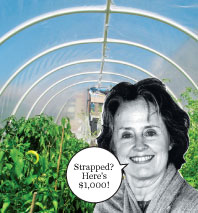 |
(Photo: Roxanne Behr/New York Magazine; Frederick M. Brown/Getty Images (Waters)) |
Spring 2009: As they construct the first of several organic grow spaces in the backyard, packed with hose-irrigated planters full of peppers and tomatoes, they hit another cash crunch. Alice Waters happens by for a visit and cuts a check for $1,000 on the spot.
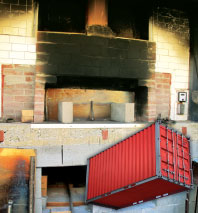 |
(Photo: Roxanne Behr/New York Magazine; Olive Cleve/Getty Images (Container)) |
December 2009: Patrick Mullins, late of Sullivan Street Bakery, initially baked bread using the off-duty pizza oven’s residual heat. Now he has his own oven: built out back on a cinderblock frame inside yet another shipping container.
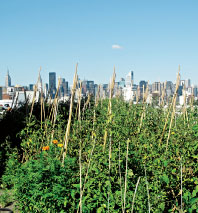 |
(Photo: Roxanne Behr/New York Magazine) |
July 2010: Brooklyn Grange, a 40,000-square-foot farm on top of the old Standard Motor building in Long Island City, launches. It’s jointly run by the Bushwick crew and urban farmer Ben Flanner, and provides produce for Roberta’s and restaurants like Blue Hill, Bobo, and Frankies Spuntino.
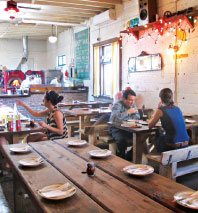 |
(Photo: Roxanne Behr/New York Magazine) |
Present: An adjacent building, a former auto-supply shop that recently became available, is soon to become a banquet hall. TV shows and a movie around the topics of food and sustainability are in the works. And this winter, they hope to put a hothouse on top of the bread oven, to make use of the unused space and radiant heat.
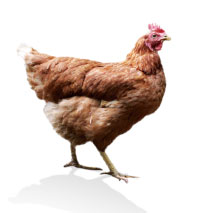 |
(Photo: Finn O'Hara/Getty Images) |
The Future: “Ideas aren’t our problem,” Parachini says. It’s a shortage of time, money, and personnel that holds back their more speculative notions. There’s been talk of excavating a pit out back and sinking a shipping container to use as a cheese cave. An on-site chicken run is on hold because of neighbor issues (they’ll probably end up putting it at Mirarchi’s father’s house on Long Island). And early talk of a goat pen has given way to visions of a farm upstate.

